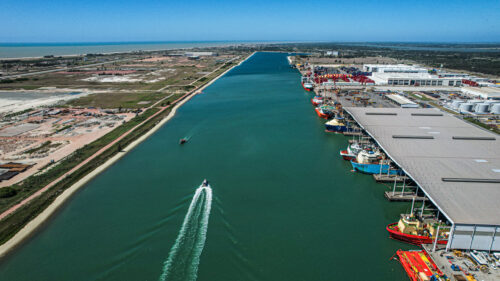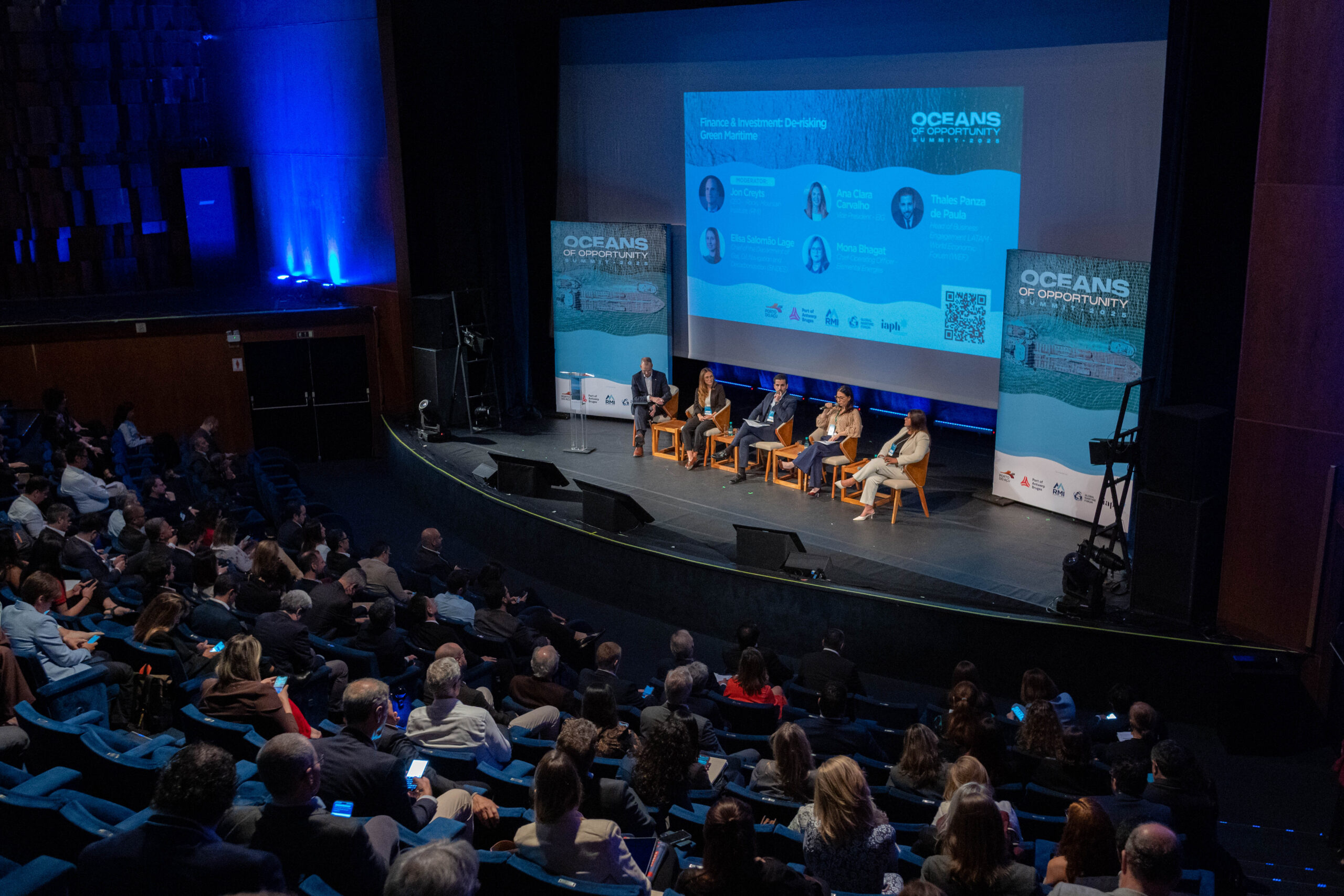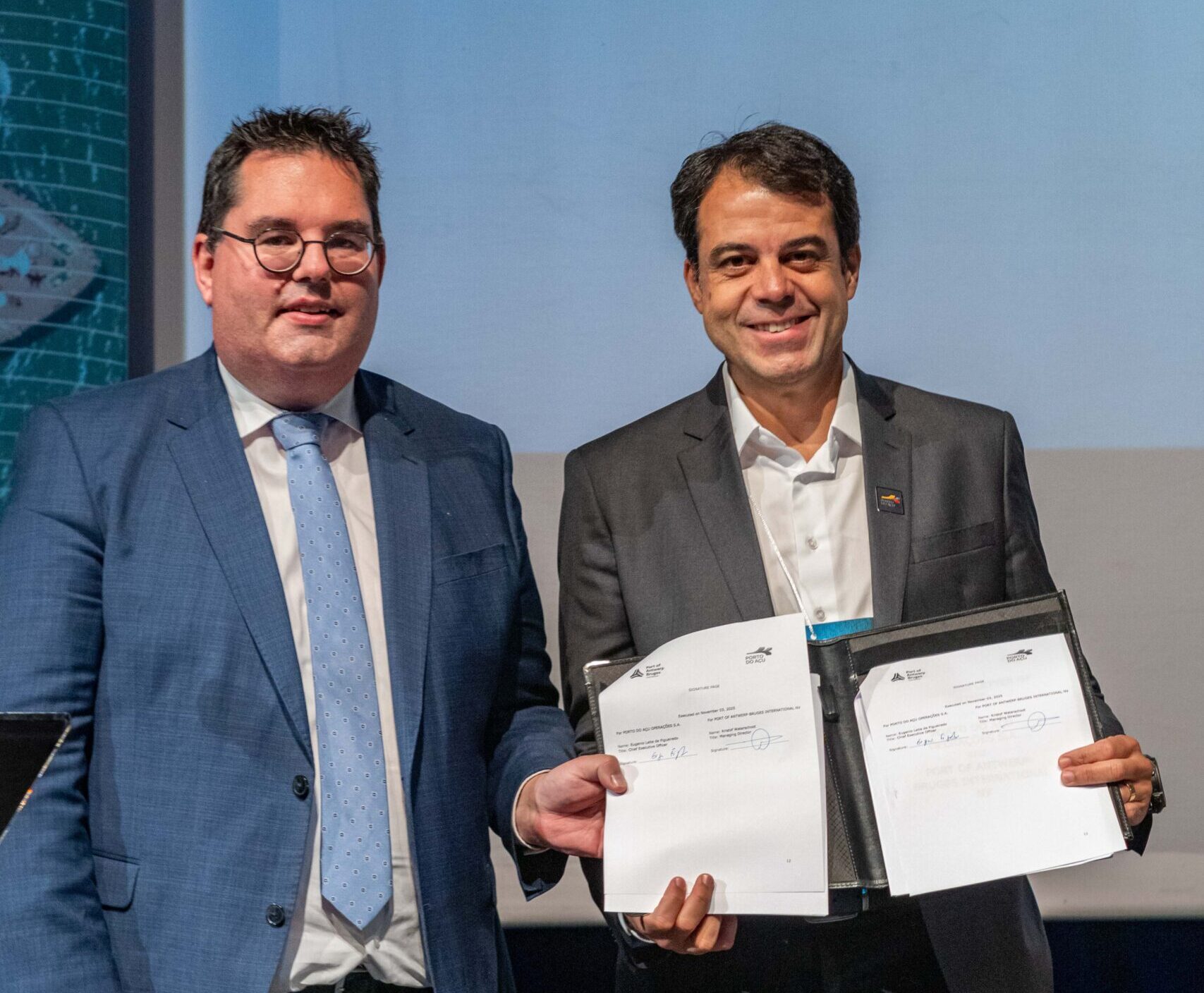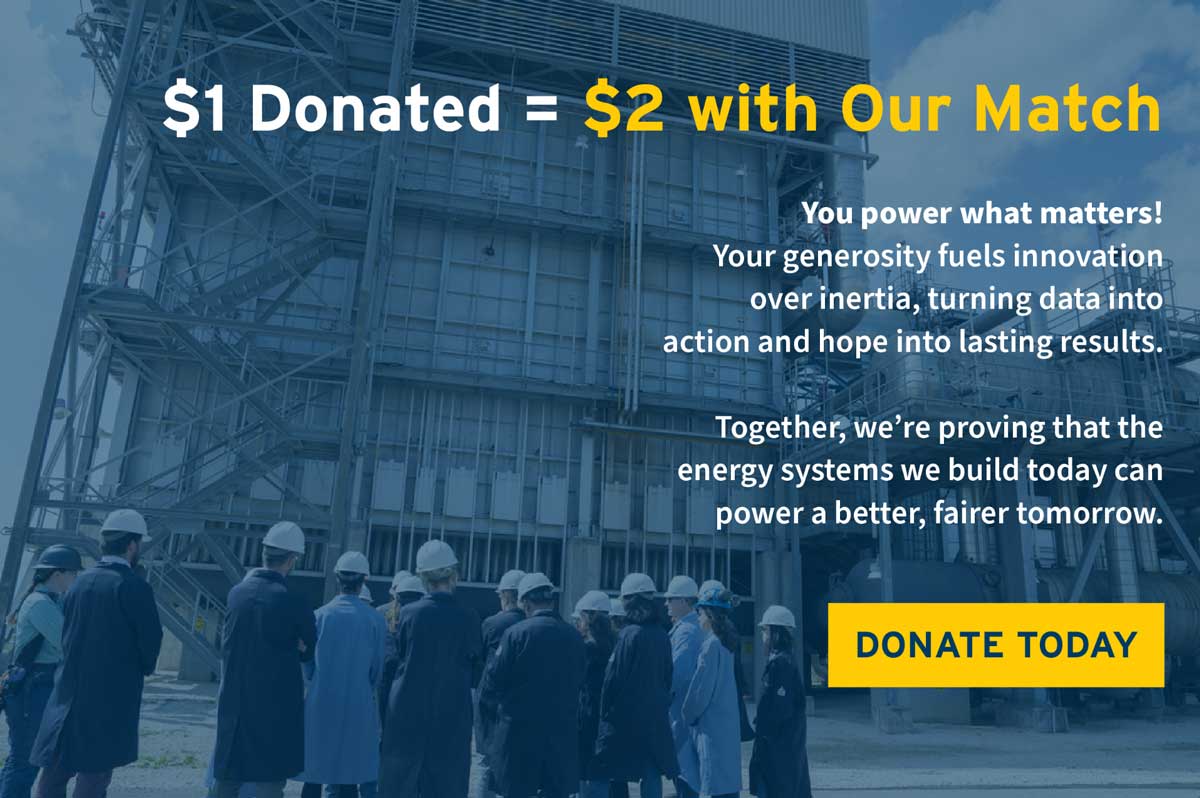
Why Brazil Is Positioned to Become a Leading Green E-Fuel Exporter
Momentum builds as an Acu-Antwerp corridor is identified as a high potential green e-fuel export corridor with considerable stakeholder interest.
Highlights
- With its largely renewable grid, strong political support for low-carbon hydrogen, and abundant freshwater and biogenic carbon supply, Brazil is set to be a globally competitive e-fuel producer.
- Momentum for Brazil’s e-fuel opportunity was apparent at a convening of senior maritime and energy leaders at the Oceans of Opportunity Summit in Rio de Janeiro just ahead of COP30.
- Hosted by Port of Açu, Port of Antwerp-Bruges, RMI, the Global Maritime Forum, and the International Association for Ports and Harbors, the dialogue focused on e-fuels, exploring the Brazilian opportunity and launching a pre-feasibility study for an Açu-Antwerp maritime e-fuel export corridor.
- The Açu-Antwerp corridor is a high-potential route where vessels can approach cost parity with conventional fuels under supportive European policy.
- A prospective coalition is now exploring what could become the world’s first major e-fuel export corridor, with operations targeted as early as 2030.
Earlier this month in Rio de Janeiro, a critical piece of the maritime decarbonization puzzle fell into place. The Oceans of Opportunity Summit brought together senior leaders from ports, shipping companies, energy developers, financiers, and government to advance Brazil’s e-fuel export opportunity. The gathering highlighted Brazil’s emergence as a maritime e-fuel powerhouse and discussed a pre-feasibility study conducted by RMI that reveals a strong business case for a green e-fuel export corridor from the Port of Açu to the Port of Antwerp-Bruges.

Brazil’s competitive advantage: World-class conditions for low-cost e-fuel production
Brazil has positioned itself as an emerging green fuel leader with unique advantages that set it apart from competing global production hubs. Its world-class renewable capacity, largely renewable grid, and abundant biogenic carbon and freshwater make it one of the most attractive locations for e-fuel production globally.
In addition to strong e-fuel production fundamentals, Brazil has advanced its regulatory landscape in recent years. The National Hydrogen Program (PNH2) signaled Brazil’s ambition to become a competitive global producer and develop low-carbon hydrogen hubs. Building on this, the Legal Framework for Low-Carbon Hydrogen created the National Certification System (SBCH2) that will certify emissions aligned with international standards. Additionally, the tax benefit regime, Rehidro, was created along with tax credits through Low-Carbon Hydrogen Development Program (PHBC).
“Brazil is facing a major opportunity for e-fuel development, supported by a unique confluence of geographic, policy, supply and demand factors that will position the Port of Açu as a leader in the low carbon maritime transition.”
Together, these regulatory advancements enable certifiable decarbonization, e-fuel export certification compatibility, improve project bankability, and support the development of e-fuel hubs like the Port of Açu.
The Port of Açu is already a significant industrial hub in Brazil, and it is primed to support the development of significant e-fuel projects. As one of Latin America’s largest deepwater and private port-industrial complexes, it has joined the World Economic Forum’s Low-Carbon Industrial Clusters initiative and is positioned to drive decarbonization in hard-to-abate sectors.
The Port of Açu has also generated interest from e-fuel developers. Açu-based developers have announced projects of up to 800,000 metric tons per year of e-methanol and 2.5 million metric tons per year of e-ammonia. As with any global e-fuel project, they face uncertainty, and not all announced volumes may materialize. Securing offtake is critical to improving viability, and green e-fuel export corridors to Europe can provide Açu-based projects with access to one of the world’s fastest-growing green fuel markets.
IMO policy framework could shift maritime economics toward zero-emission fuels
The International Maritime Organization’s Net-Zero Framework, which is on the Marine Environment Protection Committee’s (MEPC) October 2026 agenda for adoption, could fundamentally shift the economics of maritime decarbonization if adopted. New greenhouse gas regulations and fuel-intensity standards create increasingly favorable conditions for zero and near-zero-emission fuels, providing the financial incentives the sector needs to transition. Under proposed IMO reward incentives, zero-emission vessels running on ammonia or methanol can narrow or even eliminate lifetime cost premiums compared to conventional fuel operations on the Brazil-Europe route.
E-fuel exports to Europe can de-risk and accelerate production scale-up at Port of Açu
The European Union’s regulatory framework — combining FuelEU Maritime mandates with Emissions Trading System (ETS) requirements — already initiates a market pull for zero-emission fuels. These policy frameworks could generate significant demand within the next decade.
European industrial and maritime sectors are already driving appetite for green fuels across Northwest Europe’s major industrial clusters and shipping routes. Demand by 2035 could amount to almost 12 million metric tons per year of green ammonia, considering demand from the fertilizer, refining, and maritime sectors, and almost 4 million metric tons per year of green methanol, considering demand from the maritime sector.1
The Port of Antwerp-Bruges, among the continent’s largest industrial and bunkering hubs, could capture about 15 percent of EU green-fuel demand. This figure reflects estimated demand in Belgium and portions of Germany, together with the Port’s stated estimates and ambition for the markets it aims to serve. The port is rapidly expanding its multi-fuel infrastructure, with methanol handling already underway and ammonia capability expanding.
Strong momentum: Senior maritime leaders convene to advance the Açu-Antwerp corridor
The Oceans of Opportunity Summit demonstrated clear momentum for Brazil’s e-fuel opportunity. The convening of senior leaders from ports, shipping lines, energy developers, financiers, and government officials confirmed the sector’s commitment to making this opportunity operational.
The workshop that followed convened a smaller group, bringing together actors interested in potentially forming a consortium for the delivery of an Açu-Antwerp green fuel export corridor. E-fuel producers, port authorities from Açu and Antwerp, and shipping lines with zero-emission-capable vessels all joined the dialogue, underlining the sense of interest
“We are working for the Port of Açu to become a global hub for the export of zero-emission marine fuels, strategically positioned to connect Brazilian production with Europe’s growing demand for low-carbon solutions. The creation of the corridor reinforces our strategy to be the port of the energy transition in Brazil.”
High-potential corridor: Pre-feasibility confirms strong economics and path forward
RMI’s pre-feasibility study presented at the summit confirms that the Açu-Antwerp corridor is a high-potential route for multiple reasons. First, demand signals from European ports and industrial clusters provide greater demand visibility for Açu production, as the Port of Antwerp-Bruges is one of Europe’s largest bunkering hubs and petrochemical clusters. Second, vessel economics on the Brazil-Europe route can approach cost parity with conventional fuels under proposed IMO reward scenarios. Third, the infrastructure requirements are buildable on realistic timelines to support e-fuel exports at the Port of Açu and imports at the Port of Antwerp-Bruges.
Despite its high potential, the corridor faces several challenges. Greater clarity is needed on the extent to which Açu-based projects will be EU RFNBO compliant. The IMO Net-Zero Framework’s adoption was delayed until 2026, adding uncertainty around how significant net-zero fuel incentives will be for the maritime sector. Lastly, while exports to Europe provide some of the best global offtake conditions, securing firm offtake agreements remains difficult. These challenges can create uncertainty and reduce project bankability. However, increased collaboration across the supply chain can help overcome them, underscoring the importance of green corridor consortiums.

The coalition is now pursuing what could become the world’s first major e-fuel export corridor. The next phase involves a comprehensive feasibility study that will refine these findings with greater precision: detailed delivered-cost modeling, feasible offtake structures that prioritize maritime demand, confirmed vessel and engine availability, including pilot fuel requirements, and a financial structure that strategically layers IMO rewards, EU incentives, and Brazilian programs. Export corridor operations are targeted to begin between 2030 and 2035.
Why these findings matter beyond one corridor
The Açu-Antwerp corridor represents a breakthrough moment for maritime decarbonization. It demonstrates that green fuels can be produced competitively in the Global South and delivered to demand centers with improving economics that narrow the gap with conventional fuels, especially as policy incentives are developed.
The timing is critical. The Rio summit came just a week before COP30 in Brazil, and the maritime sector — responsible for nearly 3 percent of global emissions — has long been considered one of the hardest-to-abate industries. Barriers are solvable: the technology is ready to scale, the infrastructure is buildable, and the economics are tractable. Now it’s time for industry action. From Açu to Antwerp, Brazil is poised to steer the world’s first major e-fuel corridor—turning the tide toward a net-zero ocean.
“Brazil has the ingredients to lead the world on competitive sustainable shipping fuels. It has great renewables, natural carbon, a thriving resource industry and connectivity that will make it a global powerhouse in the next energy economy and position it as a leader to get us there.”
The Oceans of Opportunity Summit was convened by RMI, the Global Maritime Forum, Prumo Logística/Port of Açu, Port of Antwerp-Bruges International, and the International Association of Ports and Harbors.
[1] RMI analysis. For simplicity, all refining and fertilizer demand is assumed to be met with ammonia. Refining and fertilizer demand is based on EU RED III RFNBO 2035 mandates. EU maritime demand is based on current bunkering volume, fuel demand forecasts, and IMO’s striving 2030 target of 10% by energy replaced by green ammonia and methanol. The 10% target is assumed to be fulfilled with 65% methanol and 35% ammonia.
